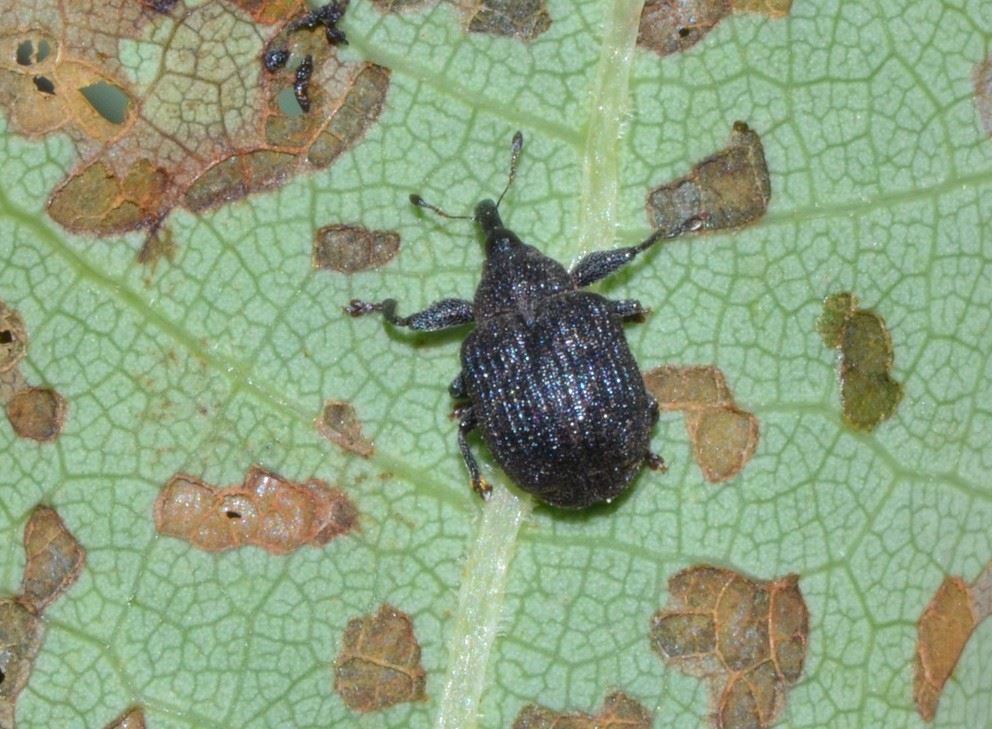The first time I noticed considerable foliar damage on our tulip poplars was last June. The reason I noticed it may be due to the fact that I planted some young trees two years ago and they are still relatively small, about six to eight feet tall. Most of the foliage is at eye level so it was easier to spot. I observed brown spots and yellowing, and upon closer inspection, saw many black beetles on the leaves. I couldn’t identify them immediately but they had elongated appendages near their noses that looked like snouts—a feature that distinguishes weevils. After an internet brief search, I identified them as yellow poplar weevil, Odontopus calceatus. Once aware of them, I started scrutinizing all our tulip poplars and found that even the tall ones (30 feet and taller) showed similar damage.
Generally, this pest is found east of the Mississippi River, where its native, preferred hosts, tulip trees (yellow poplar) and sassafras occur. The adults create bean-shaped pits where they feed on the leaves—especially those of tulip trees, sassafras, southern magnolias, and sweetbay magnolias. The larvae also cause blotchy leaf mines. The adults are more conspicuous, as a summer generation emerges suddenly in late June. They look like large ticks and people often mention the “flying ticks” they find on their clothes.
As with most leafminers, this pest is easier to manage if the adults are targeted. Every few years, an overabundance of adults emerge in June and July. This turns out to be more of a nuisance than seriously damaging to plants. Various control methods for this beetle include biological control, which involves natural parasites and predators that attack the larvae and pupae within the leaf mines. Cultural control can be achieved by eliminating preferred host species, such as sassafras trees and sweetbay magnolias. Chemical control involves applying a contact or stomach insecticide to kill the adults as soon as they begin feeding on the leaves. Several systemic insecticides are registered for control of leaf-mining insects and are effective in controlling the larvae. The best time for application is when the eggs have just been laid or while the mines are still greenish in color. Once the pupae are present in the mines, it is too late for the insecticides.
This must have been one of those bumper crop years for the weevils as there were numerous adults on most leaves. Much of the damage by the larvae had already occurred so I set out to deal with the adults. Since the trees were planted close to the gorilla yard, I could not spray any conventional insecticides. I decided to dislodge the adults with daily blasts of water from the hose. I also set up an impulse sprinkler to help knock them off and discourage repopulation. After a few weeks they disappeared, but I understand that the adults would normally persist for only a few weeks. Next year I will be vigilant and check for the adult weevils, which overwinter in leaf litter until spring temperatures cause trees to produce new leaves, usually in April and May. The adults feed for a period of time and eventually, mated females hollow out a small pit in the lower mid-vein of a leaf and deposit one to 15 eggs. And the cycle begins again. Most of the information in this article and more details about this insect can be found at: https://bugguide.net/node/view/51464

Submitted by Susan Pierce, Pittsburgh Zoo